
Harmony DAC – Design and Technical Aspects
Like all products in the LAiV lineup, the Harmony DAC’s unibody design is CNC’d from a block of premium aluminum, which yields reduced vibrations and interference.
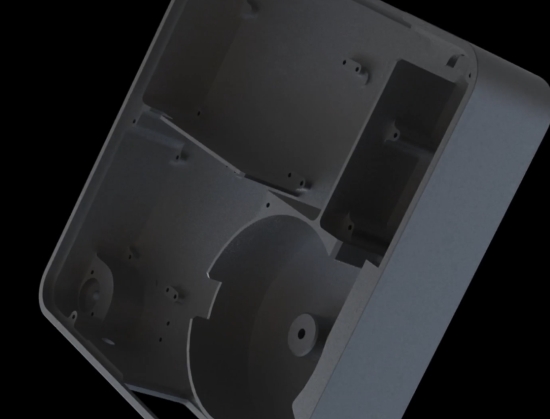
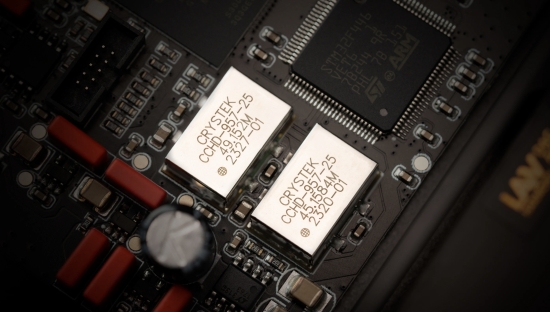
The Harmony DAC is built with top-tier components such as Crystek ultra-low phase-noise Femto crystal oscillators, Audio Note Kaisei capacitors, and Rubycon ZLH capacitors, which are carefully integrated into every vital part. The internal layout is realized in a flexible, modular manner.
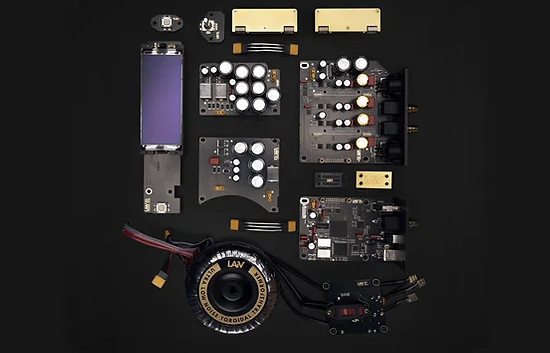
D to A conversion is done via a Balanced Discrete R-2R ladder DAC using carefully arranged individual resistors with a tolerance of 0.05%.
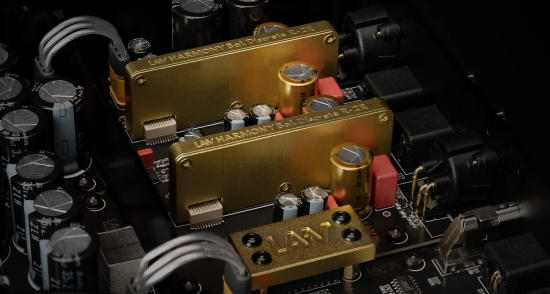
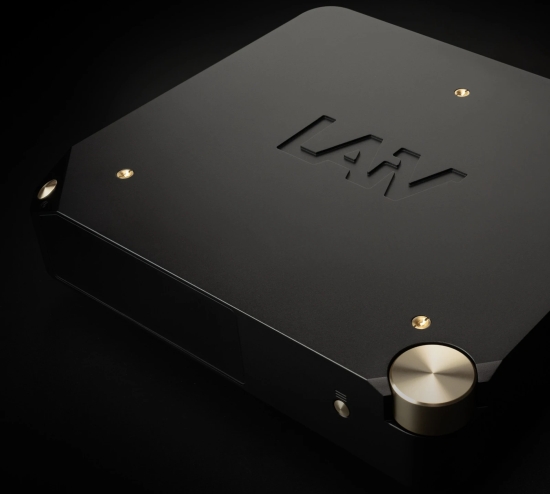
The DAC oozes style with its beautiful, seamless, minimalist design, using only two buttons. Whereas minimalist designs can often make for cumbersome or confusing operation, the Harmony DAC is simple and intuitive to use.
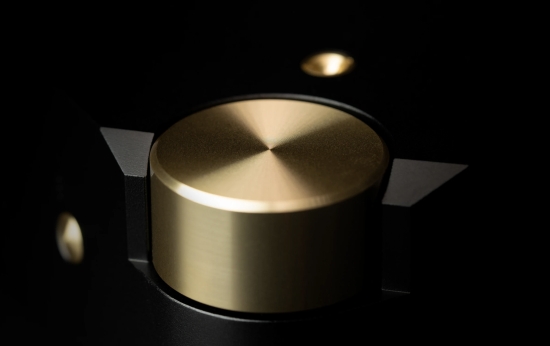
The rotary dial selects sources and menu items and doubles as a push button to confirm selections. The placement and directionality of the controls is designed with ergonomics in mind. They ensure that users can confidently operate them without concern of accidentally pushing the DAC out of position.
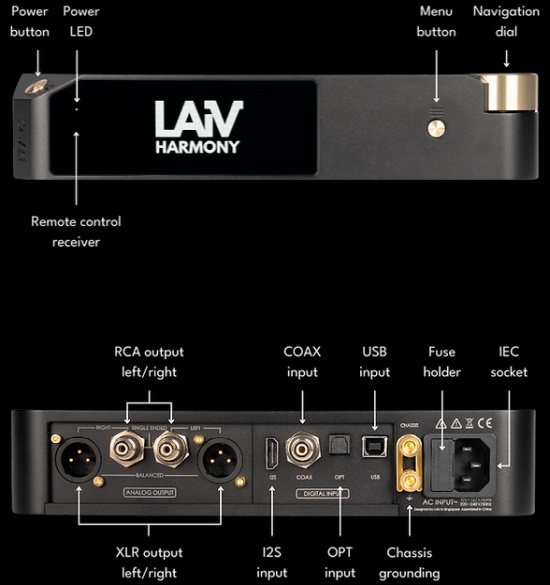
Analog outputs are provided for unbalanced RCA and balanced XLR. The user manual indicates it is best to use one or the other, not both simultaneously. Usually, this indicates the two outputs are not individually buffered, which, in turn, often indicates a purist design. Digital inputs are provided for I2S, S/PDIF on Coax, TOSlink, and USB. Supported sample rates are 44.1kHz – 768kHz PCM via TOSlink and Coax and 44.1kHz – 768kHz PCM and DSD64 – DSD256 via USB and I2S. Somewhat unusual but very conveniently, the DAC offers the option to couple or decouple the chassis from the ground.
The front panel is dominated by a 3.83-inch diagonal white monochrome 16-bit greyscale monochrome OLED display with a 320 x 132-pixel resolution. The display always shows the relevant values in an extra-large font, readable from a considerable distance.
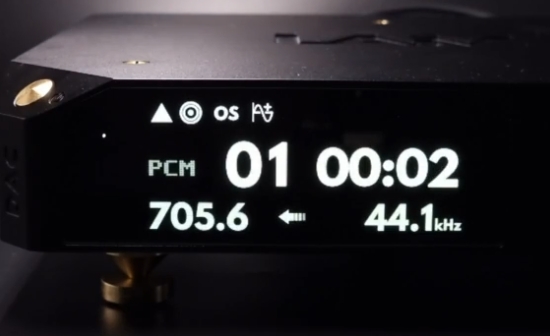
Uniquely, the DAC can automatically retrieve Track ID and Play Time from compatible CD signals over S/PDIF. This did not work with the Aqua La Diva M2 CD Transport, presumably due to the player’s custom digital output section. The M2 has a super-large display, so the function is not missed in my case, but this feature can be a huge blessing for the many CD transports with tiny displays.
With the I2S Master Clock capability, one can choose between the local DAC clock and the I2S source clock when using the I2S input. Thanks to intelligent auto-configuration, I2S setup is effortless, as LAiV devices automatically sync to the most suitable I2S mode.
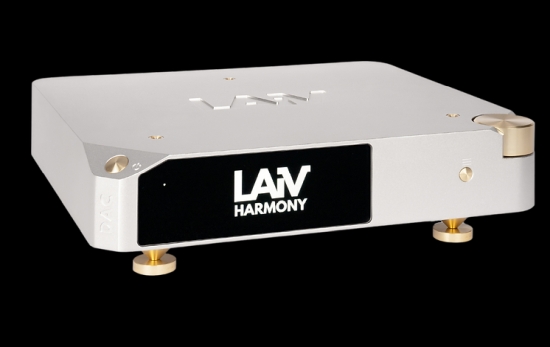
The Harmony DAC is also available in Silver
Running In and Burning In
The manufacturer recommended burning in the unit for around 100 hours. After connecting it, the DAC was used for well over a week before listening commenced, meaning it should be well run.
With OLED displays, there is a potential for burn-in when high-contrast data is shown for a prolonged time. Some screens are more vulnerable to this than others, so I checked this with the manufacturer to be sure. Mr. Weng Fai Hoh confirmed that setting the display to ‘dim’ and enabling the ‘display off’ feature will significantly reduce the risk of screen burn. In the dimmed state, the brightness is reduced, but the text is still easy to read. The display-off feature automatically switches the display off after a predefined time and switches it back on upon user interaction.
Next: Review Context, Listening, and Conclusion

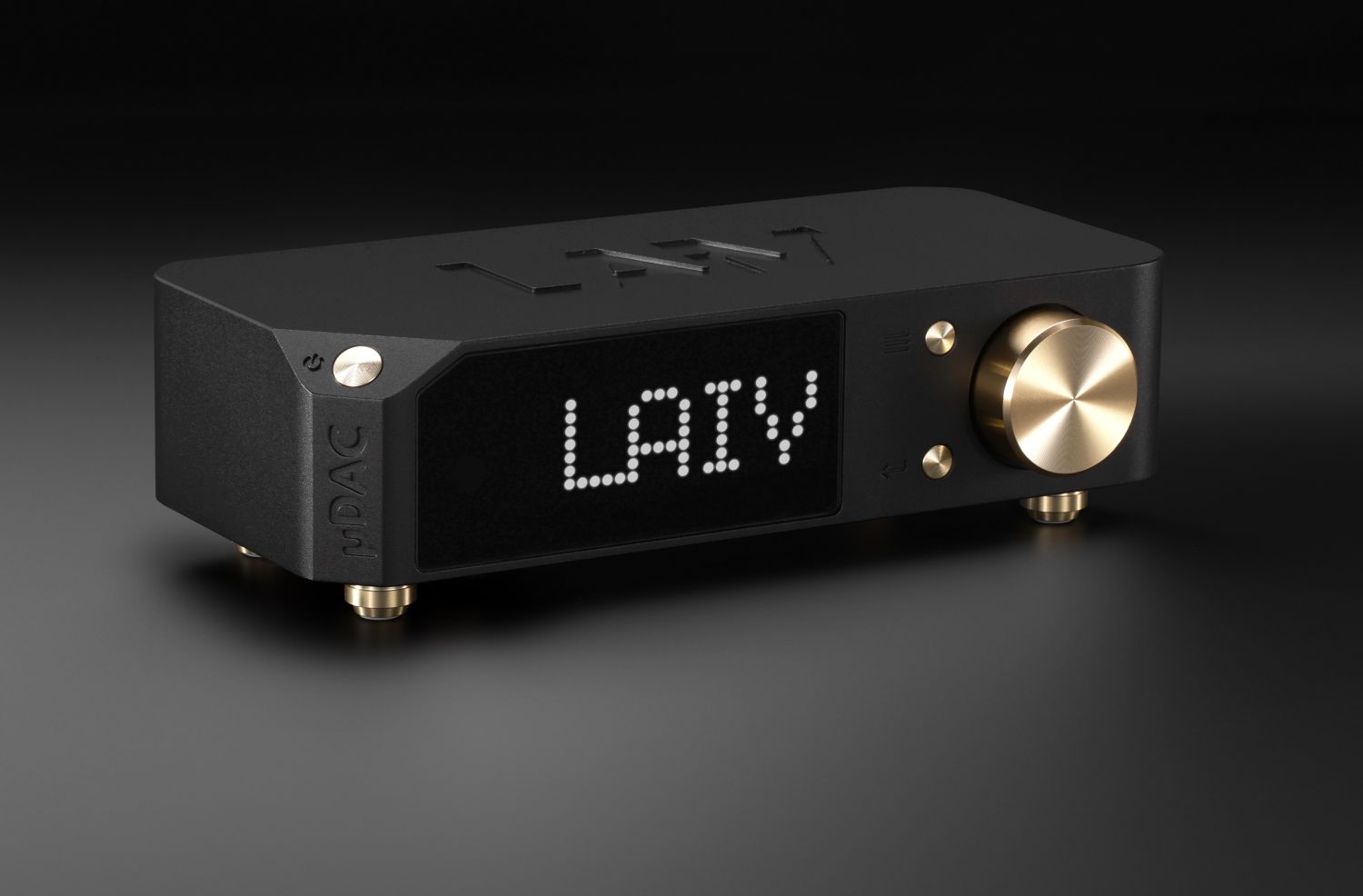





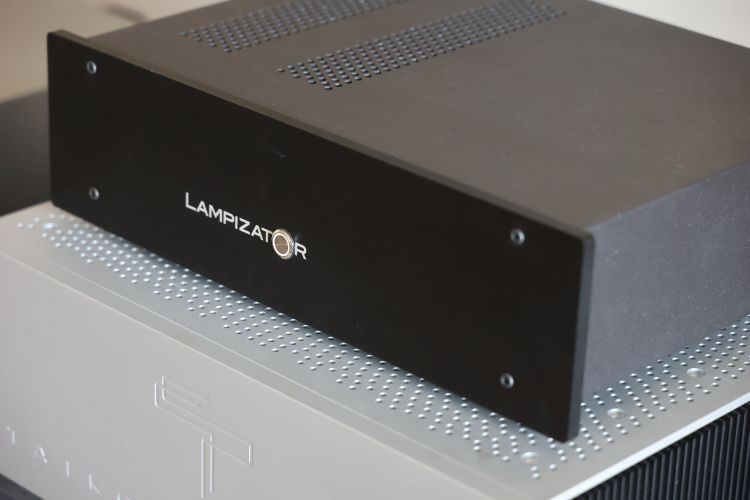
Nice review, thanks! Questions: how would you describe the sound stage (width/depth) of the Harmony? What qualities will improve when switching to a CNO DAC (like TOTL Wadax, Taiko, MSB etc)?
Hi Vincent, the Harmony DAC sounds upfront and well-focused. The stage is not narrow although some DACs in the same price range can sound wider. On the other hand, those DACs are invariably also less resolving. The Aqua Formula xHD has a deeper soundstage but it does not feel as crisp and direct as the Harmony DAC.
I don’t think people entertaining Wadax, MSB, or CH will consider a 2700-euro DAC, but I can see how it may be of interest the other way around. If you’re interested to know how close the Laiv gets to reference performance, I can say closer than one might expect given the large price disparity, but certainly not as close to make me want to switch. All brands and DACs have their inherent qualities, but overall, what you often gain in the ultra high end compared to medium-priced products is increased naturalness, refinement, soundstaging, and air. Interestingly, I find there’s not often a huge increase in resolution.
Your statements regarding USB cables and power cables are laughably ridiculous. How gullible do you think your readers are? How about we do a truly blind test of these cables? I’ll gladly wager real money that the author cannot tell one cable from the next. Real money wager. Please take me up on it.
Hi Christiaan,
what I missed was a comparison vs the Aqua Formula DAC.
So if you did this comparison without mentioning it in the review I am very curious to get some info about this comparison. I ask since you compared another DAC which is on my shortlist vs the Aqua Formula. Thank you.
The Laiv Harmony and Aqua Formula xHD are in such a different price class that I feel it would not make much sense comparing them. I know I have, and often still do involve ultra-high-end equipment in affordable equipment reviews, but it depends on the circumstances, and whether I feel it is needed to bring the message across. At the end of the day, I can do comparisons forever, but I’ve been told my reviews are already quite long;-). In a nutshell: the Formula xHD sounds fuller, sweeter, and more laidback with deeper staging, whereas the Laiv is crisper and more direct and upfront. The resolution between the two is comparable although the Laiv can appear clearer due to its crisp presentation.
Hi Christiaan,
Your observations on improvements depending on inputs used, that is coaxial versus USB are well noted. I would love to see the same with respect to I2S
Kindest Regards
Hi Tim, Good point! I forgot testing that, but will do! Please expect an update of the review within the next hours:-).
Hi Christiaan,
I like very much your reviews since you are a reviewer who does very valid comparisons. Many reviewers don’t dare to compare devices.
However, I would like to suggest that every device under review gets a comparison versus your reference components in your main system even when there is a big price difference. This would be very helpful.
Thank you very much.
Hi Matt, I will surely involve the CH C1.2 when I see a need for it. For instance, when reviewing other reference-class DACs. Another circumstance could be when a cheaper DAC outperforms the more expensive one. In that case, I will definitely mention this. However, in this case, where the balance is as one would expect with such an expensive DAC, with the CH performing on a higher overall level, mentioning this doesn’t add anything in my opinion.
Great review! I love this DAC
A typically excellent and thorough review thanks Christian and a very stylish Dac. I can see it making a lot of listeners happy eyes and ears both.
Cheers,
Jon
Hi…now there is very interesting things with all these R2r dacs and this price niche of a Laiv Harmony – as you allready tested bunch of Denafrips dacs and from price point i think this Laiv is in line with Denafrips Venus how you would compate this two (btw it look that new Pontus 15th is a Venus 12th in a box of Pontus) ….Thank you in advance….
Hi Denis, I have not heard the Pontus 15th and do not know the specifics. The latest model iterations sure are making things confusing. In any case, I have written a few words about Denafrips versus Laiv in the review above.
Hi Christiaan,
Very nice review!
I just switched from Naïm to Audionet Humboldt. Speakers Magico S3mk2.
Streamer NDX2 has to go soon.
Do you think the Harmony DAC is a good match? Thinking of buying a Grimm MU1. Or do you have other sugestions?
Thank you in advance!
Kind Regards
Olivier
Hi Olivier, I think the Harmony DAC will work very well with Magico S3 MkII. The Grimm MU1 is one of the best Roon servers I know at the price point. Whether or not it is ideal for you depends on your personal preferences. Some Roon servers, such as those by Antipodes have a smoother and more voluptuous sound but that does come at the expense of a measure of precision and transparency. You can also move in the opposite direction, with more precise and articulate sound that can be obtained by using UPnP, and the best option at the MU1’s price point would be the XACT S1.
Hi Christiaan, can I ask you for advice?
I still didn’t buy a streamer to replace my Naim NDX2 but now I got an offer for a DCS Rossini (2018) with APEX update (2023) for 17.000.
What is your opinion about the DCS Rossini?
Groet,
Olivier
Hi Olivier, Sorry, I cannot get into topics unrelated to my articles.
Do you have a chance to try the uDDC Laiv with the Harmony Dac? I’m interested in your opinions
Thanks Mario
I am currently finalizing the HP2A + LExt IN2 review. After that, the uDDC might be a possibility, but this has not yet been discussed.
thanks
Sorry to ask about another comparison, but how would you expect that the Tambaqui might compare with the Laiv Harmony? I have a Tambaqui that I do enjoy, but I wouldn’t be opposed to downgrading to put the funds elsewhere. Also in general I do gravitate to the crisper presentation style that you noted in the review.
All I can say is that they steer in a similar overall sonic direction, but I do not know how they compare precisely. It’s impossible to provide a more detailed analysis without ever having had them side by side.
I have an Aqua transport. Can I play cd’s running I2s out into the Harmony I2s input?
Aqua’s AQLink interface might technically be compatible with other I2S devices (if the pinout matches), but the connectors are different. HDMI for LAiV and RJ-45 for Aqua. So, in order to try this, you’d have to make a custom cable.
There is an adapter to convert RJ-45 to HDMI. Good to know that the Aqua might be more compatible with other I2s dacs.
Thanks.